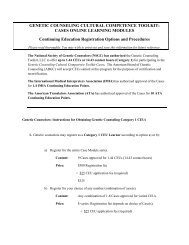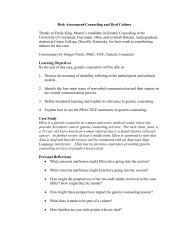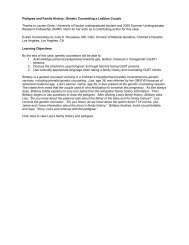making the business case for culturally and linguistically appropriate ...
making the business case for culturally and linguistically appropriate ...
making the business case for culturally and linguistically appropriate ...
You also want an ePaper? Increase the reach of your titles
YUMPU automatically turns print PDFs into web optimized ePapers that Google loves.
CONCLUSIONS AND RECOMMENDATIONSThe rapid increase in minority <strong>and</strong> LEP populations in <strong>the</strong> United States, coupled withincreased underst<strong>and</strong>ing of <strong>the</strong> importance of patient-provider communication in achievingquality health care, underscores <strong>the</strong> imperative <strong>for</strong> health care organizations to developCLAS interventions. However, many organizations that implement CLAS St<strong>and</strong>ards do sobecause <strong>the</strong>y have a culture where equity - not <strong>the</strong> bottom line - is <strong>the</strong> goal. They implement<strong>the</strong> projects because <strong>the</strong>y are <strong>the</strong> right thing to do, not because <strong>the</strong>y expect to achievesavings. As a result, some excellent examples of CLAS projects were not included in thisreport because <strong>the</strong> implementing organizations did not have any <strong>business</strong> benefit data about<strong>the</strong>se projects.There are two areas <strong>for</strong> which <strong>business</strong> benefits were sought but not found. It is particularlydisappointing that <strong>the</strong>re was nothing included on <strong>the</strong> <strong>business</strong> benefit of improving <strong>the</strong>cultural competency of physician office visits, nor <strong>the</strong> benefits of collecting racial <strong>and</strong> ethnicdata. Each of <strong>the</strong>se areas is important <strong>for</strong> different reasons <strong>and</strong> seems a logical c<strong>and</strong>idate <strong>for</strong>more work on developing <strong>business</strong> benefits in<strong>for</strong>mation.This report presents examples of <strong>business</strong> benefits achieved by organizations that haveimplemented CLAS projects. O<strong>the</strong>r areas that may yield useful in<strong>for</strong>mation in <strong>the</strong> future orthat could be useful adjuncts to this project include:• Benefits <strong>and</strong> financial costs of implementing a comprehensive, organization-wideapproach to cultural competence.• Factors or <strong>for</strong>ces that encourage management to commit to CLAS initiatives.• Peer-reviewed papers in journals on <strong>business</strong> successes of CLAS programs that reachclinicians.SummaryThis project was designed to provide in<strong>for</strong>mation useful <strong>for</strong> health care organizationsconsidering CLAS St<strong>and</strong>ards-related projects or initiatives. The findings <strong>and</strong>recommendations of Making <strong>the</strong> Business Case <strong>for</strong> CLAS provide examples that rein<strong>for</strong>ce <strong>the</strong>idea that <strong>the</strong>re are financial <strong>and</strong> o<strong>the</strong>r <strong>business</strong> reasons to pursue <strong>the</strong> provision of <strong>culturally</strong><strong>and</strong> <strong>linguistically</strong> <strong>appropriate</strong> health care services. We set out to capture <strong>and</strong> providein<strong>for</strong>mation that would support new <strong>and</strong> continued implementation of projects addressing <strong>the</strong>CLAS St<strong>and</strong>ards.Collectively, <strong>the</strong> demographic <strong>and</strong> market <strong>for</strong>ces that make CLAS in health care anincreasingly important enterprise are only one part of <strong>the</strong> l<strong>and</strong>scape. Equity in access to <strong>and</strong>use of health services, as well as reduction in racial <strong>and</strong> ethnic health disparities, are <strong>the</strong>ultimate objectives. In beginning or continuing <strong>the</strong> pursuit of <strong>the</strong>se goals, health careorganizations need not wait <strong>for</strong> better or more in<strong>for</strong>mation about whe<strong>the</strong>r to invest in CLAS.There is much work to be done in this area, <strong>and</strong> to focus on only <strong>the</strong> potential <strong>business</strong>benefits from implementing <strong>the</strong> CLAS st<strong>and</strong>ards is an unnecessary constraint to progress.28



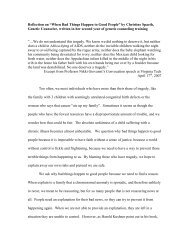
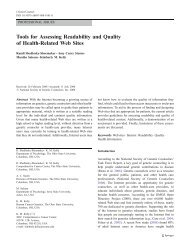

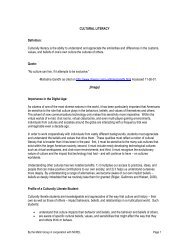
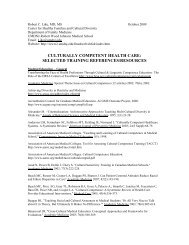

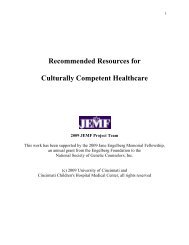
![Breaking Bad News PPT[1] - Genetic Counseling Cultural ...](https://img.yumpu.com/35003134/1/190x146/breaking-bad-news-ppt1-genetic-counseling-cultural-.jpg?quality=85)

